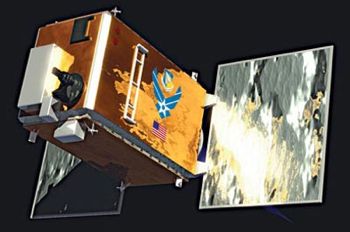
Home - Search - Browse - Alphabetic Index: 0- 1- 2- 3- 4- 5- 6- 7- 8- 9
A- B- C- D- E- F- G- H- I- J- K- L- M- N- O- P- Q- R- S- T- U- V- W- X- Y- Z
XSS
 XSS-10 Credit: Manufacturer Image |
AKA: Experimental Spacecraft System. Status: Operational 2003. First Launch: 2003-01-29. Last Launch: 2005-04-11. Number: 2 . Gross mass: 28 kg (61 lb).
The Air Force Research Laboratory (AFRL) built and demonstrated a new class of low-cost satellites -- referred to as "micro-satellites" -- weighing less than 100 kilograms. These new satellites were flown under the Experimental Spacecraft System (XSS) Microsatellite Demonstration Project.
In conjunction with the Air Force Space Command, Air Force Space and Missiles Systems Center, the Naval Research Laboratory, and industry, missions evaluated future applications of micro-satellite technologies to include: inspection; rendezvous and docking; repositioning; and techniques for close proximity maneuvering around orbital assets.
Key technologies
- Lightweight propulsion system
- Guidance, navigation & control (GNC)
- Miniaturized communications system
- Primary lithium polymer batteries
- Integrated camera and star sensor
More at: XSS.
Family: Rendezvous technology satellite, Technology. Country: USA. Launch Vehicles: Thor, Delta, Minuteman, Delta 2 7000, Delta 7925-9.5, Minotaur, Minotaur 1. Launch Sites: Cape Canaveral, Vandenberg, Cape Canaveral LC17B, Vandenberg SLC8. Agency: AFRL. Bibliography: 2, 554, 12004, 13356.
 | USA 165 Credit: Manufacturer Image |
 | XSS Credit: Boeing / Rocketdyne |
2003 January 29 - . Launch Site: Cape Canaveral. Launch Complex: Cape Canaveral LC17B. Launch Pad: SLC17B. LV Family: Thor. Launch Vehicle: Delta 7925-9.5.
- XSS-10 - .
Mass: 28 kg (61 lb). Nation: USA.
Manufacturer: USAF RL.
Class: Technology.
Type: Rendezvous technology satellite. Spacecraft: XSS.
USAF Sat Cat: 27664 . COSPAR: 2003-005B. Apogee: 811 km (503 mi). Perigee: 524 km (325 mi). Inclination: 39.75 deg. Period: 97.95 min.
On-orbit servicing technology demonstrator. XSS-10, a 28 kilogram microsatellite, was launched as a secondary payload aboard the Delta 2 launch vehicle carrying a Global Positioning Satellite (GPS) satellite. The mission demonstrated the complex interactions of line-of-sight guidance with basic inertial maneuvering. The micro-satellite was attached to the Delta 2 second stage. Once the second stage separated from the GPS satellite, the microsatellite waited for a sunlit Air Force Space Control Network pass before ejecting from the second stage. Once ejected, the microsatellite commenced an autonomous inspection sequence around the second stage, and live video was transmitted to ground stations. The entire mission lasted only 24 hours. Launch delayed from June 11 and August 16, 2001; March 6, April 29, August 11 and November 7, 2002.
2005 April 11 - . 13:35 GMT - . Launch Site: Vandenberg. Launch Complex: Vandenberg SLC8. LV Family: Minuteman. Launch Vehicle: Minotaur 1.
- USA 165 - .
Payload: XSS-11. Mass: 145 kg (319 lb). Nation: USA.
Agency: USAF RL.
Manufacturer: Lockheed.
Class: Technology.
Type: Rendezvous technology satellite. Spacecraft: XSS.
Decay Date: 2013-11-12 . USAF Sat Cat: 28636 . COSPAR: 2005-011A. Apogee: 872 km (541 mi). Perigee: 840 km (520 mi). Inclination: 98.80 deg. Period: 102.10 min.
Delayed from November 9, 2004; January 19, March 18, 2005. Military Autonomous Rendezvous Technology. It tested navigation technologies for rendezvous that directly measured relative position to the target satellite. It was have to rendezvoused with several defunct American satellites. However it was only known to have conducted operations with its own Minotaur upper stage
Back to top of page
Home - Search - Browse - Alphabetic Index: 0- 1- 2- 3- 4- 5- 6- 7- 8- 9
A- B- C- D- E- F- G- H- I- J- K- L- M- N- O- P- Q- R- S- T- U- V- W- X- Y- Z
© 1997-2019 Mark Wade - Contact
© / Conditions for Use